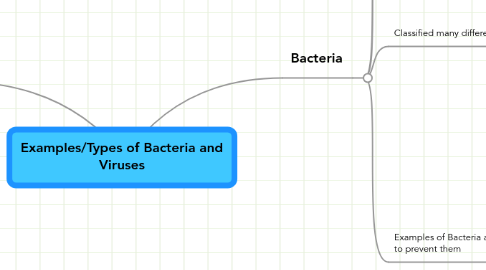
1. Bacteria
1.1. Too small to be seen by the Naked Eye
1.2. Bacteria are organisms made up of just one cell. They are capable of multiplying by themselves, as they have the power to divide. Their shapes vary, and doctors use these characteristics to separate them into groups.
1.3. Classified many different ways
1.3.1. Classifications based on Shape and bichemical properties
1.3.1.1. Three Main shapes
1.3.1.1.1. rod (rod shaped bacteria are called bacilli), sphere (sphere shaped bacteria are called cocci) and spiral (spiral shaped bacteria are called spirilla).
1.3.2. Classifications based on the requirement of oxygen for their survival.
1.3.2.1. Bacteria those need oxygen for their survival are called Aerobic bacteria and bacteria those do not require oxygen for survival are called anaerobic bacteria.
1.3.2.1.1. Anaerobic bacteria cannot bear oxygen and may die if kept in oxygenated environment (anaerobic bacteria are found in places like under the surface of earth, deep ocean, and bacteria which live in some medium).
1.3.3. Classifications based asas ‘Gram Positive’ bacteria and ‘Gram Negative’ bacteria
1.3.3.1. based on the results of Gram Staining Method (in which, an agent is used to bind to the cell wall of the bacteria) on bacteria.
1.3.4. Classified as Autotrophic or heterotrophic bacteria
1.3.4.1. Autotrophic bacteria (also known as autotrophs) obtain the carbon it requires from carbon-dioxide. Some autotrophs directly use sun-light in order to produce sugar from carbon-dioxide whereas other depend on various chemical reactions. Heterotrophic bacteria obtain carob and/or sugar from the environment they are in (for example, the living cells or organism they are in).
1.4. Examples of Bacteria and how to prevent them
1.4.1. Staphylococcus Aureus
1.4.1.1. Present in the nasal passages, throats, hair and skin of 50 percent of healthy people, according to the U.S. Food and Drug Administration (FDA)
1.4.1.1.1. What can you do? :Wash your hands frequently (including under your nails), bathe daily and keep any cuts clean and well covered. Also, keep foods hot or refrigerated until serving.
1.4.2. Vibrio
1.4.2.1. Eating food infected with Vibrio causes diarrhea, abdominal cramping, nausea and headache. In people with weakened immune systems, certain varieties of Vibrio can infect the bloodstream and be life-threatening.
1.4.2.1.1. What can you do? :Only eat shellfish, that have been thoroughly cooked. The bacteria also exist in seawater and can infect an open wound while you're swimming.
1.4.3. Escherichia coli (E. coli)
1.4.3.1. Certain strains are toxic and produce a serious infection that causes bloody diarrhea and sometimes kidney failure.
1.4.3.1.1. What can you do? : Only eat ground beef that has been thoroughly cooked, wash fruits and vegetables thoroughly before eating, wash your hands frequently
2. Viruses
2.1. Too small to be seen by the Naked Eye
2.2. They can't multiply on their own, so they have to invade a 'host' cell and take over its machinery in order to be able to make more virus particles.
2.3. Classification
2.3.1. (+/-) double-stranded DNA
2.3.1.1. Bacteriophages
2.3.1.1.1. Papovaviruses
2.3.1.1.2. Adenoviruses
2.3.1.1.3. Herpesviruses
2.3.1.2. Papovaviruses
2.3.1.3. Adenoviruses
2.3.1.4. Herpesviruses
2.3.2. (+) single-stranded DNA
2.3.2.1. M13
2.3.2.2. Parvoviruses
2.3.3. (+/-) double-stranded RNA
2.3.3.1. Reoviruses
2.3.4. (-) RNA
2.3.4.1. measles
2.3.4.2. mumps
2.3.4.3. respiratory syncytial virus (RSV)
2.3.4.4. parainfluenza viruses (PIV)
2.3.4.5. rabies
2.3.4.6. influenze
2.3.5. (+) RNA
2.3.5.1. polioviruses
2.3.5.1.1. New node
2.3.5.2. rhinoviruses (frequent cause of the common "cold")
2.3.5.3. noroviruses
2.3.5.4. yellow fever virus
2.3.5.5. tobacco mosaic virus (TMV)
2.3.6. (+) RNA Retroviruses
2.3.6.1. HIV - 1
2.3.6.2. HIV - 2
2.3.6.3. HTLV - 1
